England's Birmingham Airport route network begins to reflect its ambitions
The UK's Birmingham Airport enjoyed one of its best ever years in 2015. Britain's seventh biggest airport serves its second largest city, and recent route gains lend weight to its drive to grow accordingly.
The airport has stiff competition from huge hubs such as London Heathrow and outright low cost airports such as London Stansted alike, quite apart from local rivals. Birmingham is similar to mid-sized businesses in other industries in that it feels the pinch from either side of the economic spectrum. But with essential infrastructure in place, the prospect of a high-speed rail line, and aggressive route marketing Birmingham Airport is finally closing in on the status that its public and private sector owners demand.
The concentration of direct routes from Birmingham is clearly on Europe while existing and planned routes, some of them quite new since the opening of a runway extension, are evident in the Middle East and South Asia, in addition to two US routes.
This report looks at present and future growth trends at Birmingham airport, the local airport statistics, how the airport matches up to competing airports on either side of its catchment area across a range of metrics, at construction activities and at its ownership.
A large city-region in the heart of England
Birmingham is the leading city of the metropolitan county known as the West Midlands, with a combined population of 2.8 million, making it marginally the largest built-up area in the UK after London. The West Midlands is also the name of a higher official region (for planning purposes) of 5.6 million, which is effectively Birmingham Airport's immediate catchment area.
The West Midlands planning region

The region and the heavily urbanised West Midlands County have a more diverse economy now than in the past. While traditional heavy engineering has been in decline, it has often been replaced by high quality specialised engineering and the motor industry, which has always had a strong presence and is in a robust state.
Conventional strengths lie in advanced engineering and manufacturing, agriculture and construction, as well as business and professional services. Because of its situation in the centre of England (the town of Meriden near Coventry is said to be the geographical centre of England) and good surface transport links (road, rail) it acts as a business focal point for the West and East Midlands regions and beyond, unencumbered by natural divisions like mountains or hill ranges.
The region boasts the fastest export growth nationwide, and is the only region exporting the majority of its products and services to China. Strengths are also exhibited in the fields of food and drink, healthcare, ICT, low carbon energy and creative industries.
Birmingham Airport's catchment reaches to a wide swathe of the English Midlands. It can be reached from the Welsh border in the west to Norfolk in the east, and from the Peak District in the north to Gloucester, Oxford and Milton Keynes in the south. Its catchment area also goes over the border into central Wales.
While it broke through the 10 million ppa barrier in 2015, it lagged behind several other airports in growth last year.
Britain's 10 busiest airports in 2015, by passenger numbers, 2014 vs 2015
|
Rank |
Airport |
Pax change % 2014-15 |
2015 total |
2014 total |
|
1 |
2.1 |
74,954,289 |
73,405,330 |
|
|
2 |
5.7 |
40, 261,212 |
38,103,667 |
|
|
3 |
5.0 |
23,096,829 |
21,989,682 |
|
|
4 |
12.9 |
22,513,443 |
19,941,593 |
|
|
5 |
17.0 |
12,262,842 |
10,484,938 |
|
|
6 |
9.4 |
11,113,599 |
10,160,004 |
|
|
7 |
4.9 |
10,180,175 |
9,705,955 |
|
|
8 |
Glasgow Intnl |
12.9 |
8,709,964 |
7,715,988 |
|
9 |
7.0 |
6,781,709 |
6,339,805 |
|
|
10 |
1.0 |
4,560,485 |
4,516,739 |
It is immediately evident from the table above that there was more growth in the south of England and in Scotland than there was in the Midlands or North of England. Apart from the London airports mentioned, separately London City airport, ranked 13th in the full table, grew by 18.4%. London Heathrow Airport had the second slowest rate of growth of the top 10, but that airport is constrained by capacity limitations more than any other.
The high growth rates in the south of England are accounted for by the fact that there is much more activity in some business segments, notably finance, media, creative industries and the arts. Also, the greatest amount of money is in circulation there. While disposable income as a percentage of overall income may be limited there compared with other regions, that income is still high in many cases. Furthermore, the south, and especially London, benefits more from incoming tourism than do other regions. The number of foreign tourists to the UK grew by 6.1% from 32.8 million to 34.8 million in 2013-14 and to 35.8 million (+4%) in 2015, a new record that comes at the end of six successive years of growth.
It is not evident why there were so many additional passengers at the two main Scottish airports, Edinburgh and Glasgow. Aberdeen, the main airport for the oil and gas industries registered a decline of -6.8%. Again, inbound tourism may be a factor (more to Edinburgh than to Glasgow) and there has been a large increase in international capacity at both airports.
More to the point, it may be that the economic recovery that took place in the UK in 2014-15 has not yet filtered through to the midlands and north of England to the same degree as it has in some other parts of the country. The nearby East Midlands airport lost 1.4% of its passenger traffic in 2015. Both regions can still be classed as 'post-industrial' even though numerous replacement manufacturing and service industries have been initiated.
An approximation of Birmingham Airport's catchment area
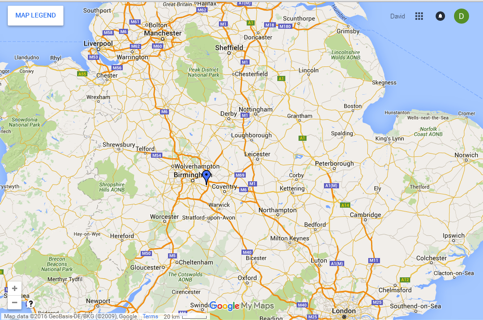
It is therefore incumbent on the Birmingham airport management to maximise passenger and cargo traffic from this vast area. However, that is no easy task as there are some powerful competitors.
Birmingham's competition comes from six airports
First, there is London Heathrow Airport, the UK's premier gateway and hub airport, which is situated approximately 100 miles (160km) distant. The M40 motorway runs from the southern part of the West Midlands County to the outskirts of London, passing Heathrow Airport close to where it joins the M25 London circular motorway. The amount of time assessed as being necessary to access Heathrow from central Birmingham by car is 1 hour 35 minutes, so a journey from the southern Birmingham suburbs or peripheral towns in Birmingham's close catchment area (e.g. Warwick, Leamington, Stratford and the City of Coventry) could easily take less than that. Accordingly, a high level of passenger traffic is lost each year to Heathrow, with its plethora of global routes and airline alliances. Those alliances additionally generate hub traffic that matches the total passenger volume of any regional UK airport.
London Luton airport, 90 miles southeast and accessible by the M6/M1 motorways, and London Stansted airport (123 miles), the UK's premier 'low cost' airport, also pose a threat. The former grew by 17% in 2015 as it attracted more low cost and charter passengers. Stansted is primarily a low cost airport benefitting from growth out of an extended range of Ryanair flights. Stansted is not as accessible as Luton from the West Midlands since drivers must use a trunk road, rather than motorway-standard road, for part of the journey but that road (A14) is to be upgraded.
Manchester Airport is only 70 miles to the north of Birmingham and its catchment area overlaps with Birmingham's in the north of the city, while the area known as The Potteries (pop 500,000) and centred on the city of Stoke on Trent is a battleground between both airports. The Manchester and Birmingham city-regions are almost identical in population and the two cities vie for the title of 'Britain's second city,' but Manchester has stolen a march on Birmingham, partly by way of finding new industries to replace the old ones a little sooner than its rival, partly because it is a media and sporting centre; its annual passenger throughput is over twice that of Birmingham. That situation could be reversed though, assuming that the HS2 high speed rail line is built running north from London, because it will arrive at Birmingham Airport long before it does at Manchester.
The salient point here, though, is that in the case of mid/long haul travel Birmingham has been 'pincered' by Heathrow and Manchester airports, both of which had the long runways needed for long haul flights at full loads, and Birmingham did not until Apr-2014.
Again, that situation has now been dealt with.
East Midlands Airport is the closest to Birmingham; the two airports being just 36 miles apart. It serves a heavily populated region of its own and there is a considerable catchment area overlap but EMA is not the rival it could have been since Ryanair opened a base at Birmingham in 2008 (and will increase its Birmingham services by 25% this summer). That was enough to put a halt to the aspirations of some of the alternative budget airlines that were operating at EMA. Latterly East Midlands has developed as a cargo airport (designated freighters) instead, becoming one of the most important in the country.
Bristol Airport is situated 104 miles to the southwest, a similar distance to that of London. The two airports share a common ownership but a rivalry exists all the same, as there is a wealthy area in and around the Cotswold Hills (Gloucester/Cheltenham etc.) that lies between the two of them.
Other airports that lie in the catchment area include Gloucestershire and Oxford but they operate very few commercial air services at best. Coventry Airport became a threat to Birmingham in the mid-2000s going from 0 to 500,000 passengers very quickly, but it closed to scheduled services when a planning application was rejected.
So there is a great deal of competition to Birmingham from larger and smaller airports to the south and north. In order to combat it, across the board growth in new routes, in all airline segments, has been required.
The remainder of this report provides data on various aspects of operations at Birmingham Airport and then examines the way that Birmingham Airport has been going about the business of growing routes and frequencies.
The table below compares Birmingham Airport with peer airports in the UK using a variety of metrics that include aviation and population statistics. (N.B. population figures in this instance are for metropolitan areas).
Birmingham and peer UK airports: Rankings by assorted metrics, ASKs, seats, frequencies and pax/cargo load:
|
Airport/metric world ranking |
ASKs |
Seats |
Frequencies |
Cargo payload |
Pax 2015 (million) |
City population (million) |
Ratio: pax to local population 2014 |
|
151 |
180 |
187 |
233 |
10.2 |
2.8 |
3.64 |
|
|
2 |
5 |
9 |
11 |
75.0 |
13.8 |
5.43 |
|
|
121 |
85 |
109 |
208 |
22.6 |
6.5*1 |
3.47 |
|
|
68 |
92 |
100 |
137 |
23.1 |
2.8 |
8.25 |
|
|
308 |
349 |
384 |
603 |
4.5 |
2.0*2 |
2.25 |
|
|
286 |
268 |
273 |
903 |
6.8 |
1 |
6.8 |
The table identifies the influence that London has not only on Birmingham, but also on the entire air transport network in the UK, being inter alia the second highest ranked airport for ASKs in the world. In comparison, the Birmingham ASK ranking is lower than might be anticipated because of a comparative lack of long haul services, rather than a lack of frequencies.
Birmingham's pax/population ratio suggests that it has a wide catchment area and is not so reliant on the immediate city-region.
Birmingham is also quite highly ranked for cargo payload, compared with some airports, and notably with Stansted. However, it lacks direct and nonstop freighter services (see below).
Birmingham Airport Network Summary (at 21-Mar-2016)
|
28 |
|
|
Domestic only |
2 |
|
International |
26 |
|
Total nonstop passenger destinations |
81 |
|
Domestic |
8 |
|
5 |
|
|
3 |
|
|
62 |
|
|
0 |
|
|
1 |
|
|
2 |
|
|
Total nonstop freight destinations |
0 |
|
Domestic |
0 |
|
0 |
|
|
0 |
|
|
0 |
|
|
0 |
|
|
0 |
|
|
0 |
Comparison of airports by total airlines and nonstop destinations
|
Airport |
Total airlines |
Pax traffic 2015 (million) |
Airline to pax ratio |
International airlines |
Non-stop passenger destinations |
Non-stop freight destinations |
|
28 |
10.2 |
0.36 |
26 |
81 |
0 |
|
|
80 |
75.0 |
0.93 |
80 |
165 |
15 |
|
|
17 |
22.6 |
1.32 |
17 |
144 |
15 |
|
|
42 |
23.1 |
0.55 |
41 |
138 |
4 |
|
|
13 |
4.5 |
0.35 |
11 |
44 |
4 |
|
|
12 |
6.8 |
0.56 |
12 |
71 |
0 |
A number of interesting comparisons arise out of the data. Once again Heathrow dominates the tables, but that is only to be expected. Birmingham has a high total of airlines, almost twice that of Stansted, although Stansted itself is twice the size of Birmingham as measured by passengers. Stansted is dominated by a small number of LCCs which is not the case at Birmingham;arguably the better spread of airlines reduces risk there, to a degree.
On the other hand Birmingham's airline total lags Manchester's by some margin and that reflects in the number of nonstop passenger destinations, which at Birmingham is only greater by 10 destinations than at the smaller Bristol Airport.
Regarding passenger choice, Birmingham's airline-to-pax ratio is the second lowest after Nottingham East Midlands and the difference is negligible, indicating that there is the greatest passenger choice of airlines within the peer group at the annual passenger level that exists now.
In terms of cargo Birmingham is one of only two peer group airports without any nonstop dedicated freighter destinations.
So while there are several strong plus points in Birmingham's favour it is already clear that increasing routes and frequencies in the passenger segment and nonstop operations in the cargo segment is likely to be the priority.
Route structure map shows an opportunity for Southeast Asian services
The route map below shows destinations that can be reached by direct (red) or connecting flights.
The concentration of direct routes is clearly on Europe. Existing and planned routes, some of them quite new since the opening of the runway extension, are evident in the Middle East and South Asia, as well as to the two US routes. Three regions or sub-regions are evident by their lack of routes - namely Latin America, Africa, and Southeast Asia - but it must be said that such omissions are common to almost all UK airports outside London. In the case of Africa and Latin America any such route would need to be underwritten by a high volume of full fare paying business passengers, and in their absence connecting routes are the best that can be aspired to.
Those connecting routes - for example routes to Paris, Brussels, Madrid and Lisbon - thus become a priority for onward connections to Africa and/or Latin America.
That is not necessarily the case with Southeast Asia however, where there can be sufficient economy level traffic to make a route feasible. Again, an interim fall-back position is potentially the addition of short haul routes such as Helsinki, in order to provide onward options to sub-regions such as North Asia, where Finnair is strong.
Direct and indirect (connecting) routes from Birmingham Airport

The 'heat' map below clearly illustrates the identity of the countries/regions with the greatest density of international seats. From Birmingham it is Spain that stands out as the densest country by this measure.
Birmingham Airport international capacity, seats by region heat map, 21-Mar to 27-Mar-2016
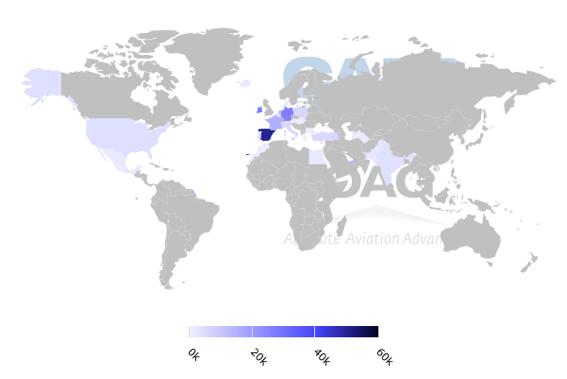
International nonstop connectivity - the same number of European routes as Heathrow
The following chart looks at international (passenger) nonstop connectivity in more detail. Connectivity became a buzz word towards the end of the Airports Commission's runway investigations. Much of Birmingham Airport's submission to that entity was concerned with both actual and potential air connectivity that would serve to (a) benefit the local population and (b) remove more of the burden from London airports in the national interest.
In this case Birmingham Airport (dark blue line) does show up on all regions and it is close behind Manchester (red line) in some of them. The most startling result is that it has almost the same number of nonstop destinations in Europe as does London Heathrow, even if there is a significant difference in capacity on most of those routes.
Unlike at Stansted Airport, whose European route total is close to twice that of Heathrow, it is not the case at Birmingham that almost all of those routes are low cost ones; many are prime business routes flown by full service or regional airlines.
Non-stop connectivity values (passenger destinations). Comparison of Birmingham, London Heathrow, London Stansted, Manchester, Nottingham East Midlands and Bristol airports, Mar-2016

Landing charges - no clear indication of positioning
What an airport charges its client airlines is obviously an important factor in the decision of airport selection, and especially where there are so many airports situated close together as is the case in the UK. While charging modes may be changing or under review landing charges remain an essential part of CAPA's data analysis and are used as a benchmarking tool.
Charges are compared among all the peer group airports apart from Nottingham East Midlands, which is not available. In this instance peak charges are shown when there is a choice between that level and off-peak, (i.e. Stansted and Manchester airports).
What the data show is that Birmingham's landing charges occupy a middling position within the peer group. In one case it is the second most expensive airport (B777-300ER), while in another it is the second cheapest (CRJ 200).
No firm conclusion can be reached other than to suggest that flexibility, compromise and individual airline negotiation with the airport could be anticipated.
Landing Charges (USD) for Birmingham Airport [BHX], London Heathrow Airport [LHR], London Stansted Airport [STN Peak], Manchester Airport [MAN Peak], Bristol Airport [BRS] for 2014

Seat capacity - a balanced portfolio between full service and LCCs
The contribution of full service and low cost airlines is split 32.5% : 57.6%, with a continuing presence from the charter segment and a small contribution from regional/commuter services.
Birmingham Airport capacity, seat share by airline type, 21-Mar-2016 to 27-Mar-2016
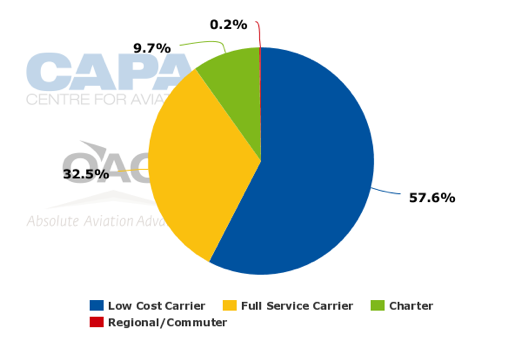
It is useful to compare this traffic split again with the airport's peer/competitors.
Comparison of selected airports by airline type - seat availability, 21-Mar-2016 to 27-Mar-2016
|
Airport |
% of seats on FSCs |
% of seats on LCCs |
% of seats on other modes (e.g. regional, charter airlines) |
Clarification of previous column |
|
32.5 |
57.6 |
9.9 |
Charter and regional/commuter |
|
|
98.0 |
2.0 |
- |
- |
|
|
0.1 |
98.6 |
1.2 |
Charter and regional/commuter |
|
|
36.0 |
51.2 |
12.8 |
Charter and regional/commuter |
|
|
1.1 |
82.7 |
16.2 |
Charter and regional/commuter |
|
|
7.9 |
80.2 |
11.9 |
Charter and regional/commuter |
What is clearly apparent from this table is the remarkably large split between the highest and lowest percentages of full service and low cost seat availability (London Heathrow vs. Stansted, where the two are completely in contrast) and in general the vast variation throughout it, which is representative of the often extreme segmentation of UK airports.
Secondly, Birmingham, one of few UK airports able to claim this, has a balanced portfolio of air services with contributions from all four segments - full service, low cost, regional and charter. It is bracketed in this respect with Manchester and also with London Gatwick, which does not appear in this or other tables because it is not considered to be a direct competitor. London Gatwick currently has 30.4% full service seats, 61.2% low cost and 7.3% charter/regional-commuter.
Another way of looking at it might be that these three airports (Manchester-Birmingham-Gatwick) form a spine down the centre of England. The only thing separating Birmingham from the other two airports is size, and the reasons for that have been discussed previously. Manchester is twice as big, and Gatwick four times as big. Birmingham could argue that it is as much a 'business airport' as is Manchester. The percentage of low cost seats is slightly higher at Birmingham but it does not have the same impact from the charter segment as does its northern rival. That segment has been in consistent decline for over a decade, although it has levelled off lately and there is evidence of a slight resurgence, especially in the long haul arena.
From this evidence alone it appears that there is considerable scope for Birmingham to grow more quickly than Manchester. Manchester's route network in Europe is almost maxed out now, meaning that growth can really only come from frequency increases or gauge increases.
Furthermore, if there are any more delays to the construction of another runway in the south of England (and that possibility should never be written off), Birmingham is without doubt the best-placed airport in the UK to provide alternative short to mid-term capacity solutions that are applicable to all airline categories. Ministers, MPs and civil servants will have taken note of that during the Airports Commission information gathering stages when Birmingham's lobbying was intense.
No airline dominates at Birmingham
The distribution of seat capacity by individual airline is detailed below.
The balance in seat capacity is again evident here in a different way, with no individual airline having more than 21% of it. That airline is the UK's hybrid airline Flybe, Europe's largest regional airline, which has made Birmingham its main base. Operating both UK domestic and short haul international routes Flybe is symbolic in some ways of what Birmingham Airport stands for, with high frequencies to important destinations for both business and leisure customers.
That there is no dominant airline also reduces pressure from monopolistic interests to respond uniquely to their needs.
Birmingham Airport capacity (seats per week), by all airlines, total system, 21-Mar-2016 to 27-Mar-2016

The presence of Monarch Airlines and Thomson Airways as the third and fourth largest airlines should not detract from what has been said previously. Monarch Airlines continues to reposition away from its previous charter activities towards scheduled operations in Europe, mainly, serving many secondary level cities at primary level airports.
Thomson Airways has been a mainstay at Birmingham for decades. While it remains a charter airline it could follow the lead of Thomas Cook Airlines (which also operates out of a Birmingham base) by introducing long haul scheduled services, which Thomas Cook is doing at Manchester this year.
The charter airlines are changing, and airports like Birmingham are best placed to supply the support they need in order to do so.
International capacity - nearly a quarter is to Spain
Equally, there is no dominant country in respect of international capacity. Spain has the largest capacity, as is often the case nowadays since that country is seen as a relatively safe haven for vacations in the era of terrorism against tourists.
The 7.4% of capacity attributed to the UAE demonstrates the growing strength of Gulf airlines at Birmingham. There are three daily Emirates flights to and from Dubai and the lunchtime service will be upgauged to A380 as this report is published. Qatar Airways will commence operations at the end of Mar-2016.
Birmingham Airport international capacity seats by country, 21-Mar-2016 to 27-Mar-2016
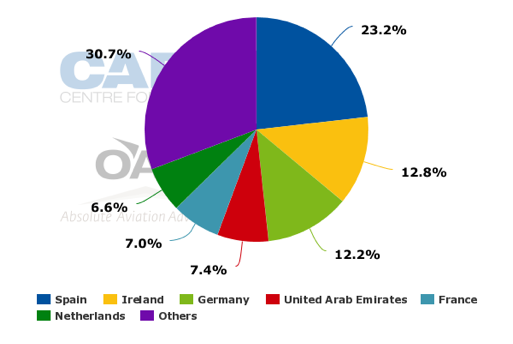
Business and premium economy lagging the world averages
The chart below shows that Birmingham's Business and Premium Economy capacity lags the world average and there is no First Class seat offer.
However, both Gatwick and Manchester airports have an almost identical scenario, so Birmingham is not at a disadvantage to them. However, it is the case against London Heathrow which, while it marginally lags that average in First Class, has a massive 10% of seats in the Business Class category.
Birmingham Airport schedule by class of seat - one-way weekly departing seats (total system) 21-Mar-2016 to 27-Mar-2016

Alliance penetration is limited, but is no great influencer
Birmingham is thus far a little unrepresented in terms of airline alliances with 80.7% of seats currently on unaligned airlines. Of the three alliances Star Alliance is best represented, followed by SkyTeam, but oneworld led by British Airways accounts for just 0.9% of seats.
Birmingham Airport capacity, seat share by alliance/unaligned, 21-Mar-2016 to 27-Mar-2016

The same group is used here as previously in comparing peer group airports on their alliance penetration.
Comparison of Birmingham with selected peer group airports by alliance penetration - seat availability, 21-Mar-2016 to 27-Mar-2016
|
Airport |
% of seats on unaligned airlines |
% of seats on aligned airlines |
|
80.7 |
19.3 |
|
|
16.5 |
83.5 |
|
|
100 |
0 |
|
|
77.3 |
22.7 |
|
|
100 |
0 |
|
|
95.2 |
4.8 |
The table suggests that the lack of an alliance presence is not so bad as it might appear. Three of the competitor airports have a lesser alliance penetration (two of them have none at all) and Manchester is only slightly ahead. It is only Heathrow Airport, with hub status, that stands out from the field.
Moreover, another way of looking at it is that formal global alliances will not influence the future growth patterns of British regional airports.
Rather, growth there will come more from independent ad hoc alliances and agreements that bypass established hubs. Birmingham Airport made much of this in its submission to the Airports Commission, which was forced to acknowledge that such a scenario was as likely as the continued pre-eminence of the current formal alliance arrangement.
Traffic grows, but rate of increase declined in 2015
Traffic has been growing in each of the last five years but in a staccato fashion, with a percentage point increase followed by a decline. However, the 10 million barrier was breached for the first time in 2015.
Previously the highest annual total was 9.6 million, in 2008. While there may be some disappointment that the annual growth rate slipped marginally below 5% in 2015, there will be some gratification that in the first two months of 2016 it is running at an average of 12.15%. Long haul especially grew, with +19% recorded in Feb-2016.
Birmingham Airport annual passenger numbers
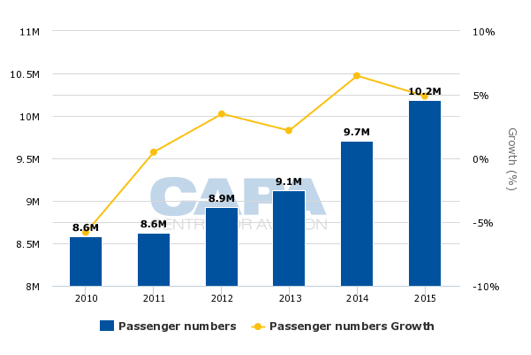
Stage lengths are short to mid-length, but lengthening
Most of the seats at Birmingham Airport (54.8%) are on flights of up to two hours in length, with 23.9% on flights of up to four hours. While there are hardly any very long flights (in excess of 10 hours), the ratio of seats in the six to nine hour flight category is growing and will continue to grow with the addition of long haul services such as Qatar Airways.
This will inevitably have some ramifications for operational procedures, staff work rosters and external agencies such as the UK Border Agency.
Birmingham Airport, seats by length of flight, 21-Mar-2016 to 27-Mar-2016
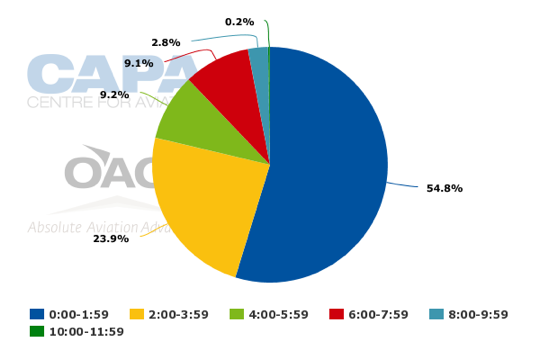
The chart below represents the data in another fashion, this time contrasting frequencies with stage lengths. The greatest number of weekly frequencies clearly falls in the stage range 0-2.5 hours.
Birmingham Airport frequencies (21-Mar-2016 to 27-Mar-2016)
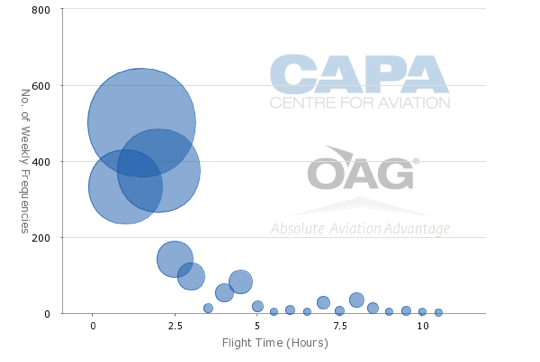
Another perspective on frequencies is represented below in the form of a bar chart of available seats (arriving and departing) by time of day, on a typical day, in this case Wednesday 23-Mar-2016. This use of seat availability broadly equates with slot usage.
Birmingham Airport follows the typical morning/evening peak fashion (0600-0900 and 1600-1800) of a British airport with substantial business traffic. There is no midday peak but there is a short one hour peak between 2000 and 2100.
Jet aircraft curfew is in place; no night movements
There are no obvious imbalances between arriving and departing passengers other than after 21.00. There is no 24/7 operation, with a night jet movement policy restricting operations of certain types of aircraft during the periods of 2300-0600 hours. This is evident from the chart below.
Birmingham Airport, seats per hour, typical day, Wednesday 23-Mar-2016 (all airlines, total system, all terminals, all origins and destinations)
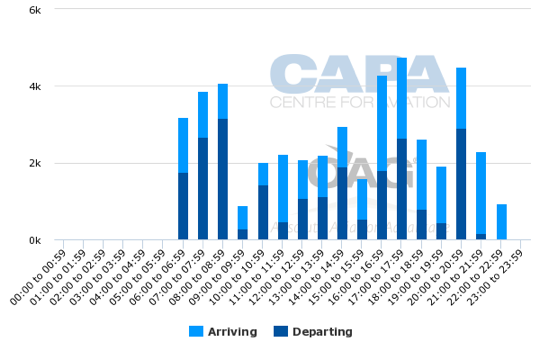
Cargo - payload on the increase and could grow quite quickly
It was hinted earlier that Birmingham is quite highly ranked for cargo payload compared with some airports, and notably Stansted. However, it lacks direct and nonstop freighter services.
In fact, insofar as its success is measured by available payload, that is increasing as demonstrated in the chart below, which spans the last two years and the first three months of 2016.
Birmingham Airport cargo payload (Kg) system-wide, per week

Of that payload capacity, 93% is on international services. Emirates has the highest with 974,000 kgs (30.4%) in the week 21-Mar-2016 to 27-Mar-2016.
Of the international cargo volume, availability is split as follows:
Birmingham Airport international capacity cargo payload, total system, by region, 21-Mar-2016 to 27-Mar-2016

100% of the airport's cargo is carried in the belly hold of passenger aircraft. There are no dedicated cargo airlines other than very small local ones, with the exception of the parcels integrator FedEx, which operates a freighter service from Birmingham to Paris with feeder services from Manchester and Belfast.
There are several possible reasons for this. Birmingham has never really had a reputation as a cargo airport. East Midlands Airport has a national as much as a regional role; there are extensive cargo operations at Stansted; and Heathrow Airport with its consolidated facilities is just down the M40 motorway. Even nearby Coventry Airport had a freight role for some time.
Furthermore, the types of goods that are typically imported and exported by Birmingham businesses - manufactured metal products, machine tools etc. - may not lend themselves to airfreight carriage other than by designated widebodied airlines. Such airlines operate at Stansted, East Midlands and Heathrow, and there may be inadequate demand for urgent shipment other than the type that can be dealt with by parcel.
But again, times change, and the arrival of a regular passenger A380 service alone will likely stimulate cargo demand in the same way as Emirates' service at Newcastle did, which is well documented.
In the short term the airport will benefit from closures at East Midlands Airport next winter since parcels integrators UPS and DHL are currently planning to use Birmingham to service their East Midlands operation during the closures.
Otherwise the Birmingham management is evaluating its strategy with regards to the airport site and considering what it can do from a cargo point of view as part of the master planning process. For the immediate future the belief is that the cargo sector could grow quite quickly following on from discussions that have been taking place with freight forwarders. The airport is consulting with various firms over the master plan, which could be "modest" or "ambitious" according to the CEO Paul Kehoe, who indicated he preferred an ambitious one.
Essential construction is mostly complete; the next major project is providing for HS2
The airport has a single terminal, a merger of two terminals having been completed in 2011 when a rebranding took place. This removed the word 'International' from the airport's title on the unusual grounds that it had been demeaned by other airports using that title when they offered few or even no international services.
With the opening of the runway extension (by 405 m to 3003 m) in Apr-2014, aircraft are able to take off from Birmingham with more fuel and fly direct to destinations such as China, South America, South Africa and the US West Coast. The runway extension was wholly funded by the airport company at a cost of GBP40 million. In addition, the airport made a further investment of GBP13 million for the construction of a new air traffic control tower and radar system, plus GBP9 million on resurfacing the entire runway and the provision of a new maintenance hangar for larger aircraft.
The runway expansion, which can handle A380 aircraft, is one part of a long-term investment programme, worth over GBP100 million in total, supporting its long term ambition of quadrupling the annual number of passengers to 36 million.
The next major project will be the construction of a train station (Birmingham Interchange) to serve the HS2 rail line from London, which is expected to commence operations in 2026. The station will be situated in the Borough of Solihull, on the other side of the M42 motorway from the airport, the National Exhibition Centre and the existing Birmingham International rail station.
The interchange will be connected to the other sites by an automated people mover. A smaller version of such a people mover already exists between Birmingham International and the airport.
Proposed location of Birmingham Interchange station
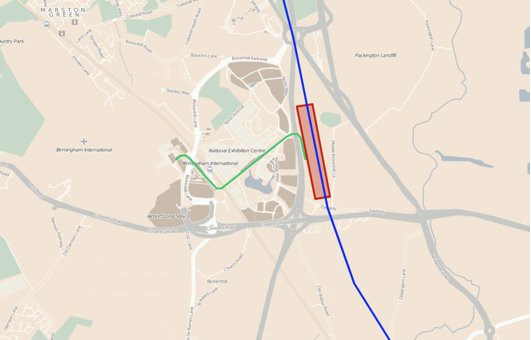
The airport management believes that passenger traffic can increase by 50% to 15 million ppa by 2025, before the implementation of the HS2 rail line and without a second runway. It is thus seeking to ensure a state of HS2 readiness in order to position the company if the stakeholders (see below) ask for a major reinvestment before 2026.
In the short term the need is to cope with the peakiness referred to earlier and accordingly extra security lanes and a 'minor remodelling' are being planned to cope with more passenger demand at peak times. The contrast is that during off-peak times the airport can be virtually empty. Thus more incentives will be introduced for non-based airlines to fly in off-peak times.
Ownership - Birmingham is a classic example of municipal and private sector cooperation
For many years Birmingham Airport had been under the joint ownership of the seven West Midlands local metropolitan borough authorities representing the public sector and a succession of private sector interests that have included:
- Aer Rianta (the Dublin Airport Authority);
- The constructor John Laing;
- National Car Parks (the UK's longest established private car park operator in its first and only airport venture);
- Bridgepoint Capital (the now 100% owner of Leeds Bradford Airport);
- Australia's Macquarie Airports (which became MAp Airports and now Sydney Airport),
- Australia's Victoria Funds Management and
- Canada's Ontario Teachers Pension Plan.
In many ways the changing ownership of the airport reflects the evolving mores of airport privatisation in the UK over the course of a decade and a half. Some of the original 'chancers' who were attracted to the transport sector privatisation drive from the late 1990s onwards ultimately have been replaced by very well cashed-up pension and other such funds which inherently invest for the long haul. Inevitably this brought some stability not only to Birmingham Airport but to many others.
Having said that, it was suggested in a previous CAPA report in 2012 that there was a 'hands-off' approach by the private sector shareholders to day-to-day management in the early days that allowed a lax attitude to procedures and planning to develop.
See related report: Birmingham Airport repositioning as a national UK gateway point
The one consistent factor has been the continued majority share ownership by the combined metropolitan councils. While it is the case that they do not always all sing from the same hymn sheet, their presence has meant that no private sector developer has been able to rush into a rashly made decision to the detriment of the airport, the councils and the general population.
The current ownership position is that OTPP (as Airport group Investments Ltd) acquired Victoria Funds Management's 19.25% stake in Birmingham Airport on 29-Dec-2014, thereby raising its own stake to 48.25%. VFM exited airport investment as a result. The remainder is held jointly by the municipal councils and a staff employee share trust, which represents marginal overall control as detailed below. OTPP made its initial investment in the airport in 2001 and increased its stake in 2007.
OTPP also has 100% ownership of Bristol Airport, which is a competitor, but the organisation appears to be comfortable with it.
Birmingham's ownership is close to a pattern in some of the larger British cities where there is a mixed public/private ownership scenario, for example Manchester and Newcastle.
They remain in the minority though, with most of the UK's largest city airports (Heathrow, Gatwick, Edinburgh, Glasgow, Leeds Bradford, Bristol, Belfast, Aberdeen etc., also Liverpool until recently) being 100% privately owned. The main exception is Cardiff Airport, owned by the Welsh Government, which acquired it from the private sector.
Birmingham Airport ownership as of 21-Mar-2016

New route development mirrors the existing belt and braces approach
This report concludes by examining how Birmingham Airport has been going about the business of growing routes and frequencies.
Earlier it was pointed out that Birmingham hosts a broad range of airline types and that while the LCC segment was strongly represented no segment was too powerful. That would also appear to be the case with the most recent announcement of new airline and route gains, which are summarised in the table below.
|
Airline |
Type |
Short or Long haul |
Route |
Frequency if known |
Commencement date |
|
L |
Doha |
8x weekly |
30-Mar-2016 |
||
|
LCC |
S |
2x weekly |
29-Mar-2016 |
||
|
LCC |
S |
4x weekly |
27-Mar-2016 |
||
|
S |
5xweekly |
22-Apr-2016 |
The Qatar Airways route in particular is a useful gain as previously only Emirates from the 'Middle East Big 3' (ME3) operated at Birmingham. The Iberia Express route opens up Latin American markets via Madrid as well as the O&D option. Perhaps the most significant gain, though, is that of Czech Airlines, which renounced its two UK routes (London Heathrow and Manchester) over five years ago and has only recently returned to the country with a brace of new cities instead, namely Liverpool and Edinburgh, prior to the Birmingham announcement.
Indeed Prague exemplifies the type of short haul route where Birmingham still has plenty of slack to play with. Rival Manchester Airport has two airlines (easyJet and Jet2) servicing Prague and realistically can only expect to grow the route further by way of frequency increases. Birmingham had no other route to Prague and gains over its rival by hosting a good starting frequency from the national airline and is thus able to offer onward connections as well as simple point-to-point travel.
In the short haul arena there are new services from the IAG-owned Vueling, which puts a British Airways presence back at Birmingham if only in disguise. There are additional routes from Wizz Air, an airline that only started operating there in Sep-2015.
Monarch Airlines, completing its transition from charter airline to short haul scheduled airline, will add routes including Lisbon, and there are new routes from Flybe (Milan, Rennes, Nantes, Rotterdam, Knock and Luxembourg, a route never previously flown).
Ryanair will increase its capacity by 25% in summer 2016.
In the long haul market, the upgauging of one of the daily Emirates services to an A380 has been mentioned. Additionally, Thomson will add a long haul route, meaning five weekly B787 charter services. Thomas Cook will have (so far undisclosed) additional routes for winter 2016. Frequency additions will come from KLM, Turkish Airlines, Icelandair and PIA.
The position of Norwegian is not yet known. It was considered as one of 2015's success stories at Birmingham, along with the extra Emirates frequency and the addition of an American Airlines flight to New York JFK. In the light of recent pronouncements by Norwegian on its growth prospects at Gatwick Airport, and the fact that it is known to be weighing up alternative airports in the UK, it is not beyond reason to anticipate it could consider long haul at Birmingham.
Otherwise there are strategic initiatives taking place, such as a 'oneworld alliance' strategy and a 'Canada' strategy (there are no year-round Canadian services to Toronto). Nearer to home there are specific cities targeted for services such as Helsinki, Stockholm, Gothenburg, Vienna and Marseille.
Returning to long haul, China remains high on the 'wanted' list. Birmingham has witnessed two summers of charter flights to Beijing and feels that a scheduled service was snatched away from it by Manchester (Hainan Airlines). Another as yet unidentified Chinese airline, has received permission to do operate twice weekly services to Birmingham - one from Beijing and one from Hangzhou.
To sum this up, what is evident is what was expressed in the title of the report: Birmingham is an ambitious airport. It led the 'regional' fight against the expansion of the London airports more than did Manchester, whose owners also had to balance their promotion of Stansted Airport to the Airports Commission. Despite being sidelined by the Commission it has lost none of its fight and still believes that there is as role for itself as the primary alternative to the London airports.
Birmingham is realising its ambitions and continues to set itself ever more ambitious targets. Those targets are underscored by a recent briefing from credit ratings agency Moodys.
Moodys reaffirmed Birmingham Airport Finance Plc's (BAF) 'Baa1' ratings of its unsecured bonds and notes through to 2041, and a stable outlook that recognises the company's "resilient operational performance and the likely substantial cash flow growth in the short term despite the increase in debt". Moodys stated that the ratings are "constrained by the level of core catchment traffic that is captured by rival airports, underlining the competition that the airport faces". However, Moodys went on to say that "recent progress has been made to address the gaps".
Summary and conclusions - salient points
- Birmingham is at the centre of one of the most heavily populated parts of the UK, as well as close to being in the centre of England;
- It was a heavily industrialised area which went into post-industrial decline. It is now recovering but has fallen behind some other regions. It remains strong in the export of manufactured goods;
- Birmingham Airport has a very wide catchment area, owing to geographical and transport-related factors but many of the residents of that area choose to use alternative airports;
- Birmingham Airport is subject to competition from six other English airports, varying in size from Heathrow Airport (75 million ppa) to East Midlands (4.5 million ppa). For high-value scheduled passenger traffic its two main competitors are London Heathrow and Manchester;
- Its broad and balanced mix of existing air services puts it at least risk from economic events that adversely affect any one airline segment, making it attractive to airlines for the same reason;
- Birmingham offers a high degree of airline choice to passengers as measured by annual passenger throughput;
- The airport has no clear advantage over other airports in its pricing structure to airlines;
- Birmingham lags airports such as London Heathrow, in particular, in terms of alliance penetration but there is no certainty that this will prove to be an inhibiting factor in its growth, since the nature of air transport continues to change. Nevertheless, there is a specific alliance strategy in place, focused on oneworld;
- Traffic growth rates have varied but are notably strong at the beginning of 2016;
- The airport does suffer from a degree of peakiness at times every day but this can be advantageous to route development. There is a jet curfew in place;
- Cargo is transported by passenger aircraft but the arrival of a number of airlines to commence operations there points to a more promising future in that segment;
- With much critical infrastructure in place, providing adequate room for growth, the next leap - a quantum one - will be in the commencement of high speed rail services (HS2) in 2026, which will require a new station that is not on the airport premises. While political opposition to HS2 remains it has progressed so far that it is unlikely to be cancelled now, although the propensity for moderation of the scheme remains. The arrival of HS2 will put Birmingham at an advantage over Manchester (and possibly even to Heathrow Airport) for a number of years;
- Birmingham stands to benefit from further delays to the construction of an additional runway in southeast England (which could even result in the re-emergence of the Thames Estuary new airport proposal);
- Birmingham has the propensity to grow at a faster rate than Manchester, which has almost maxed out on European routes and can really now only increase frequencies on those routes. Equalling Manchester's route total must be a priority at Birmingham to bring it to parity;
- Birmingham's route network structure - which is very comprehensive - is heavily focused on short haul (Europe) with some significant gaps, especially in long haul, such as Southeast Asia. However, the rate of increase in new routes during the last year has been faster than at its peers and across a wide range of airline types and regions. With the additional runway capacity that has now been available for two years Birmingham should start to reap the benefits of that capacity in the long haul arena.
See related reports: